Think before you grow – or better put: think before you spend your money. If there is one lesson to be learned from the first day of the Leafy Hydroponics Summit, this would be it. As the possibilities for automation in a lettuce facility are high, it might seem easy to set up a business, but, as all speakers emphasized, it's not easy to be successful if you don't know what customers you'll be dealing with. Whether it's your cultivation system, your LED installation, your transplant line, or your post-harvest treatment, consent is key. And by the way, without it, you won't persuade your financial institute either – and even investors might have learned the importance of it by now as well.
Click here for the photo report.
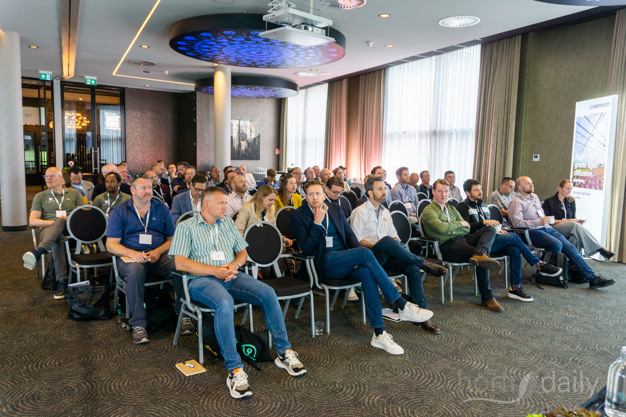
The first edition of the Leafy Hydroponics System took place yesterday in Breda, Netherlands. Organized by Cultivators, the day united 200 lettuce specialists from all over the world. The day's keynote speaker, Lambert van Horen with Rabobank, talked about the difference between financing and investing. He elaborated on the role of Rabobank. "Risk avoidance is a bank solution. We're working with savings from the other part of the balance sheet, and we're often focusing on relatively low return on investment times, low risk, and agile facilities. This can be contrary to investors, seeking high-risk and higher profitability."
Despite the challenging market circumstances, Lambert still believes in the potential of lettuce greenhouses in North America. "In general we think there's an upside in the percentage of more indoor supplied leafy greens on the shelves of the supermarket. So on the one hand there's the California production, some local indoor facilities for the high end of the supermarket shelves. We think the US could follow Europe, where in general 20% is indoor produced, and 80% is outdoor. Currently, in the US 8% is indoor grown, and 92% is outdoor. We still see there's an uptrend which can be in the supermarket."
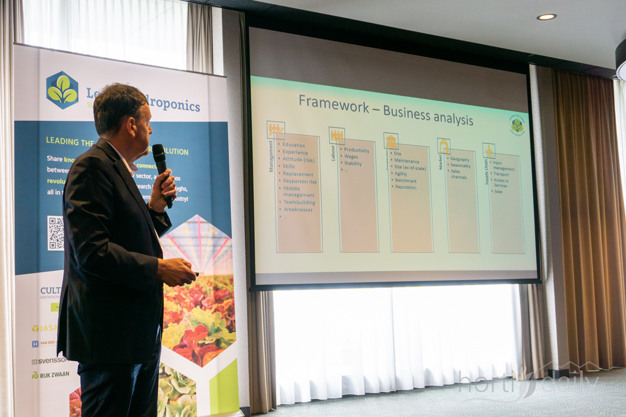
Looking at the investing level in greenhouses in the US he sees it as an opportunity in the long run. "The drive for more indoor production has started in all kinds of fresh produce, not just in leafy greens. Everywhere around the world, we are protecting our crops. Sometimes we go from outdoor to low-tech, sometimes we go from low-tech to out-of-the-soil, mid-tech, and sometimes to high-tech, carbon dioxide-adding facilities. But everywhere we see this trend to more tech up in fresh produce, especially because of population growth, purchasing power, and government policies; on the supply side, we've seen less volatility in production. So we're positive about the long-term drivers."
Next up was Marc Celis with Rijk Zwaan on preventing tip burn in Rijk Zwaan. He emphasizes defining the types of tip burn and the causes of it – which can be diverse. Trials show for example calcium contents of the plants play a role in the occurrence of tipburn – but there's more. Many of the 200+ listeners enthusiastically took notes on his tips on artificial lights, the importance of intensity, the spectrum, and how it affects the cultivation as a whole.
Joost van Rooij with Heliospectra introduced the company's product offerings and dove into the importance of the spectrum and the light intensity balance. "The higher the intensity the higher the weight. Biomass accumulation is correlated to light intensity", he said. "But is weight it all?" He explained the different product qualities growers can look into, and how a conscious choice between efficiency, output, investment, grower preferences, and goals is key.
The application of far-red is an important tool in dynamic lighting and new research shows the many possibilities. But also look into the risks, as 15-20% more far-red might result in a bigger crop, but also bring more tip burn and yellow leaves. Adjusting the far-red with 2-5% ensures a higher weight and more chlorophyll can be achieved. This is why currently 10% far-red seems highly interesting – although again it depends on the circumstances.
Click here for the photo report.
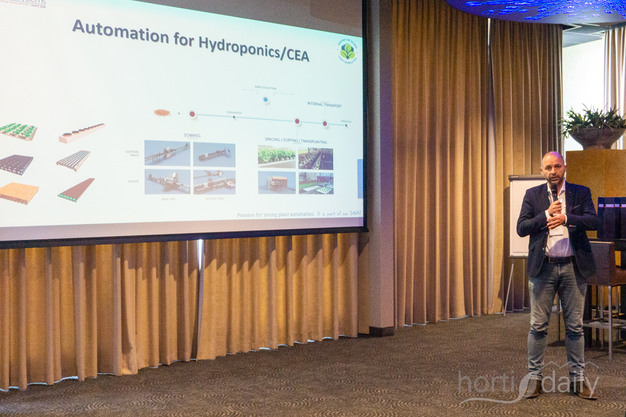
Thanks to all automation possibilities, it might seem easy to automate, showed Ad van Laardonk with Flier Systems. However, he also emphasized it's important to automate with care. "Ideal automation and mechanization solutions fit a grower's specific needs while minimizing potential risks", he showed with various examples.
After lunch, Tim van Hissenhoven with Cultivators ensured the visitors remained engaged by diving into the new types of crops and their applicability in various cultivation types. "Knowing we have a lot of types and factors to consider, there are ideal systems to grow on", he concluded. "You need to consider various types you start with a high density and end in the same way, so you don't have to replant. For baby leaf, small, and teen leaf, automated harvesting can be realized, and only teen leaf requires transplanting. Contrarily to whole head which is often transplanted, and is manually harvested." That's crucial, as optimal spacing and transplant matter greatly. An optimal density in propagation, throughout the system and end phase, is important considering, not only to prevent quality loss but also to reach the end product and plant weight at harvest.
Delivering efficiency and profitability, the goal of consulting company Cultivators is driven by food safety, quality, and consistency, which requires a growing facility, the hardware, cultivation and operational knowledge, the software, and production inputs, the genetics substrate, and nutrients. "These all affect the eventual efficiency and profitability." Copying a successful facility is not an option as local circumstances differ greatly.
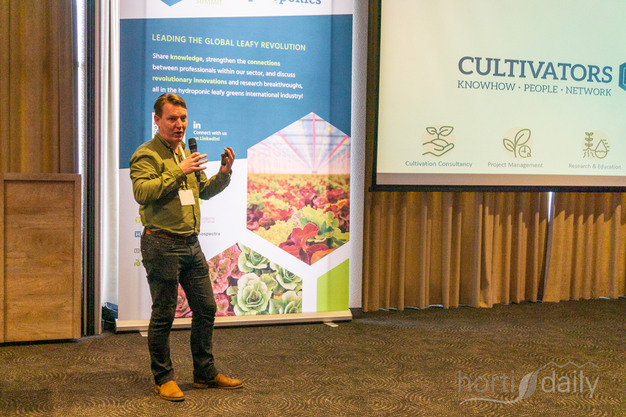
Tim looked into the differences between DFT and NFT and showed, although depending on the growing system specifics, both systems offer optional transplant steps, DFT does not offer automatic spacing between transplants, resulting in lower plant densities on average, and a lower production/m2. Cultivators created an impact of system choice for individual business cases, offering insights on how these options can optimize your business.
Diving into water quality management, Tim described it as some sort of black box – yet with a big impact on profitability. Optimizing results involves ensuring a clean start, disinfection, and proper treatment, with attention to your starting material, regular maintenance, and technical possibilities. The oxygen level and water temperature later are tools to improve cultivation further on, as are the measurements taken to avoid biofilm and to keep the pH stable.
It might be clear: after the lettuce hype, he sees the market is stabilizing, with people nowadays being more serious and asking for help. "I'm not saying vertical farming has no position in this world, but we see they are actively looking for solutions to make them more profitable." He emphasizes the importance of an economics-driven set-up, not applying tech for the tech.
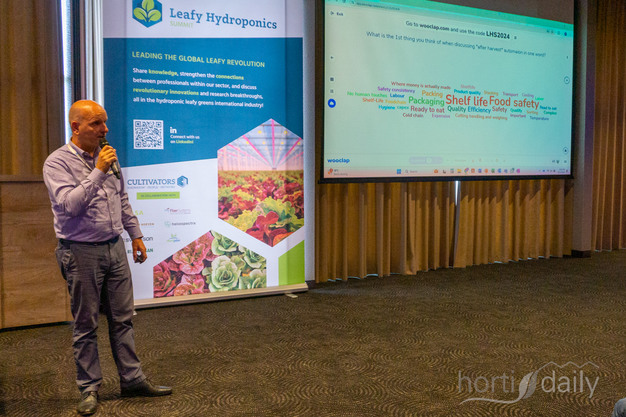
Click here for the photo report.
Next in line was Joost Somford with Jasa, who kicked off his talk by asking first thoughts on the importance of post-harvest for leafy greens, something he specializes in. He explained the process from harvest to storage. Also, he emphasized the importance of connecting with your customer and finding their true demand, as this will partly guide your choices in set-up, for example in the wanted product quality and post-harvest requests. Jasa helps growers identify this demand and guides growers through the research and process of finding the right solution. Doing so not only results in better shelflife but can also remove the need for cooling or drying facilities. "You have to get sure the whole post-harvest area gets the product out in the way you grew it, and gets it to the customer, and the consumer, in the same way." The versatile solutions of Jasa answer the volatility of the market and the customers. "I personally think we go to bagging solutions, as it is the most sustainable and cheapest. But now people expect a high-quality leafy green in a tray. We see state by state changing over to bagging, from food service to bagging. The world is changing, and if you're looking to invest, this is important to look at: what are you doing in 5 years." Jasa uses their experience and international network to identify trends like these.
Preparation is more important as it takes time to set up a facility, and it enables you to prepare for automation as well: realizing processing and output numbers, but also defining your budget, the comparison vs labor, and the breaking point. "It makes no sense to invest in automation if it will not bring you revenue", he simply says.
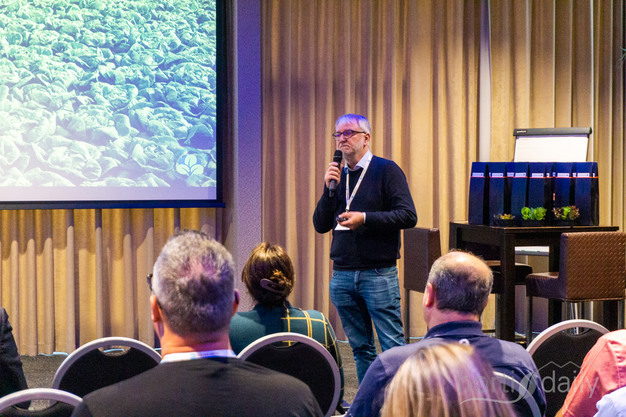
Kurt Cornelissen with Hortiplan talked about teen leaf production and the difference between direct seeding versus transplanting. Hortiplan specializes in the mobile gully system.
Direct seeding offers high flexibility in seeding density and is fit for the smallest leaves. No operator is required. Space efficiency however is lower, as is the germination rate, and there's no replacing possibilities of non-germinated seed. Also, it requires a higher investment. Opting for one transplant, with an individual plug, is a cheaper option and enables flexibility in substrate choice, and selection of transplanting of young plants. Surface can be used maximally, resulting in a higher output/kg/m. The system is suited for individuals up to 100%. However, it's not ideal for the smallest leaf length and you're dealing with fixed plant holes, reducing your flexibility over time. Again, selecting the best option depends on your market demands: direct seeding will result in smaller leaves, and a large amount of non-lettuce, whereas one transplant is suitable for larger leaves, and mostly lettuce.
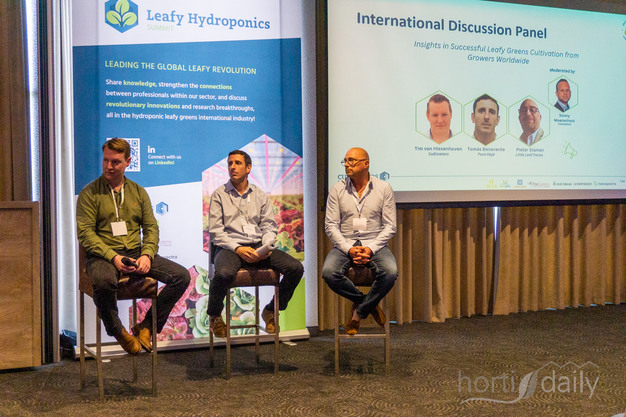
So – enough of the suppliers, let's actually hear some growers' stories. Pieter Slaman with Little Leaf Farms and with Pura Hoja opened up about real-life farming, while Tim van Hissenhoven with Cultivators brought a global perspective. Their stories showed that in the end, it remains a grower's world: there are guidelines, automation, plans, and advice, but in the end, a green thumb remains a necessity. Especially given today's circumstances, with pressure increasing in terms of climate, pests & diseases, labor management, and increasing costs of irrigation and fertilization, balancing it all is not an easy task. Suppliers might know the tech, but growers know their crop.
Marc Middeldorp with Van der Hoeven elaborated on semi-closed greenhouses and how to activate air flow in lettuce production. Minimal air exchange is one of the goals, re-using as much as possible to prevent a closed climate. Yes as all air goes upwards, climate exists at the top. "The outside climate is a source of air, not an influence. You want to minimize the usage of resources. The way we do it is to disturb the boundary layers around the leaves. We're manipulating convection, aka the air movement. All year round, every moment of the day." It results in a continuous air movement throughout the greenhouse, not just at the top.
He talked about how the evolution of greenhouses results in increased yield, food safety, innovation, and sustainability – but again the business risk and resource usage are higher.
The company did a life cycle analysis on their ModulAIR greenhouse, showing that although it's more expensive to buy, it results in lower CO2 usage per kg lettuce compared to a Venlo greenhouse. He added inputs of the greenhouse, turn out to be only 3% of the total CO2 output, with energy being the biggest one over the total lifespan This is partly thanks to the specific design, created with an easy setup in mind. "Easier to clean, and adiabatic cooling in the night, quite often diminishing the need for cooling – although this of course can be added as well." By mixing heated and cooled air, ideal temperatures in the greenhouse can be reached. "If your greenhouse has been designed correctly, we can help you create the perfect climate for your crop."
The final talk of the day was for Ton Habraken with Svensson. He discussed the different functions of a thermal screen, including thermal insulation, light transmission, heat emission, moisture, and air permeability, and creating diffuse light ("please measure in Hortiscatter over Haze"). Ton, and his heat camera, showed the effects of these functions on a crop, the uniformity of the climate in the greenhouse, and the crop temperature. Their solutions ClimaFlow and ParPerfect are developed to increase penetration of the crop by creating diffuse light, and vertical air movement to ensure optimal crop production.
Click here for the photo report.
For more information:
Leafy Hydroponics Summit
cultivators.nl
